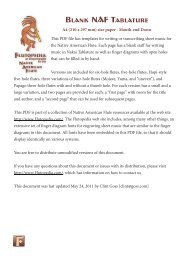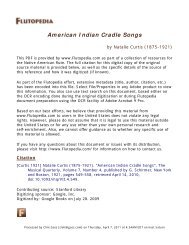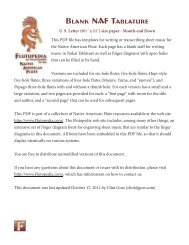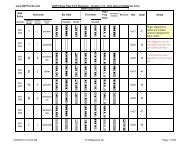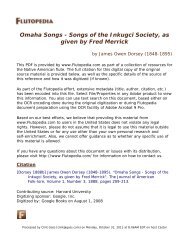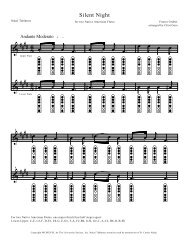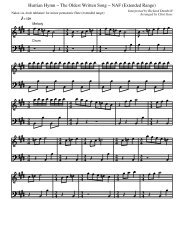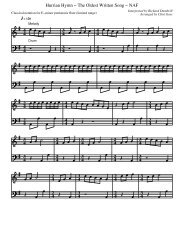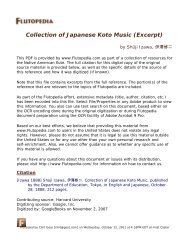Music of Acoma, Isleta, Cochiti, and Zuñi Pueblos - Flutopedia.com
Music of Acoma, Isleta, Cochiti, and Zuñi Pueblos - Flutopedia.com
Music of Acoma, Isleta, Cochiti, and Zuñi Pueblos - Flutopedia.com
Create successful ePaper yourself
Turn your PDF publications into a flip-book with our unique Google optimized e-Paper software.
Dbnsmorb] pueblo music -.AS^rJi'<br />
87<br />
No. 62.<br />
Buffalo Dance song (c)—Continued<br />
'>''^<br />
u\UY^'W^^Uirr-i^rY\JTJ =^<br />
fr<br />
^'i r \i r<br />
'<br />
11^<br />
;i^<br />
BC ?2:<br />
F^P4f-^H<br />
Analysis.—This song was difficult to transcribe as ttie pitch was lowered a semitone<br />
<strong>and</strong> the time increased suddenly, then increased gradually as indicated. The<br />
pitch was gradually lowered while the tempo was increasing. This is not shown<br />
in the transcription which is on the original pitch. A slight lowering <strong>of</strong> pitch<br />
level was heard in some other renditions by this singer. He stated, however, that<br />
he was not aware <strong>of</strong> such a custom among the <strong>Cochiti</strong>. He learned many songs<br />
from his gr<strong>and</strong>father <strong>and</strong> it is possible that he learned them with a lowering <strong>of</strong><br />
pitch <strong>and</strong> did not realize it was intentional.<br />
OUWE DANCE SONGS<br />
In February, before there is any planting, the <strong>Cochiti</strong> dance the<br />
Ouwe dance in order that they may have good crops. Each kiva<br />
group has its own songs <strong>and</strong> rehearses them for several weeks before<br />
the dance. The costumes are elaborate <strong>and</strong> the dancing begins about<br />
9 o'clock in the evening, continuing until 3 or 4 o'clock in the morning.<br />
Four times during the night the people <strong>and</strong> singers from the Squash<br />
kiva visit the Tiu^quoise Idva <strong>and</strong> sing, the visit being returned by<br />
members <strong>of</strong> the Turquoise group. In the dance <strong>of</strong> the Squash people<br />
the men are in the front line <strong>and</strong> the women behind them. A man<br />
with a drum st<strong>and</strong>s still in front <strong>of</strong> the dancers. The songs mention<br />
every sort <strong>of</strong> vegetable <strong>and</strong> ask for an abundance <strong>of</strong> each.<br />
The following song, like others recorded by Evergreen Tree, was<br />
used by Indians belonging to the Squash kiva, <strong>and</strong> he demonstrated<br />
the gestures that were taught him by his father. These were in the<br />
nature <strong>of</strong> a pantomime concerning the subject <strong>of</strong> the song <strong>and</strong> ac<strong>com</strong>panied<br />
the singing.



